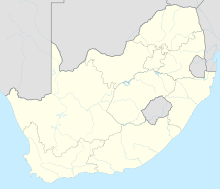Tswaing
Coordinates: 25 ° 24 ′ 30 ″ S , 28 ° 4 ′ 59 ″ E
Tswaing ( setswana for 'place of salt'), English also ( Pretoria ) Saltpan , Afrikaans Soutpan , is an impact crater in the Gauteng province of South Africa , around 40 kilometers north-northwest of the capital Pretoria .
description
The crater has a diameter of about 1.13 kilometers, a wall height of about 60 meters above the surrounding landscape and, measured from the highest point of the crater rim , a depth of 119 meters to the present day crater floor.
There is a smaller crater lake here , which is fed by rainwater and - about 50 meters below the level of the wider area - also by groundwater . On evaporation of his very salty ( hyperhalinen clear) water changes because of the small depth of a few meters, the size of the lake, on the exposed seabed sediment and salt can bloom .
The Tswana used the place as a salt spring for several centuries and called it Salzort, setswana Tswaing . In the first half of the 20th century, table salt and soda were commercially extracted from the brine at the bottom of the crater lake . Some ruins of the buildings erected for this purpose are still visible.
The dam reaching into the lake was built later in order to drill holes in the middle of the lake and to determine the geological properties of the subsoil in more detail. This also clarified the origin of the crater.
Emergence
For a long time it was assumed that the bowl-shaped depression of the earth's surface was of volcanic origin and represented a caldera . The interpretation put forward in the 1930s that its shape was the result of an impact was controversial for decades. Only investigations of a drill core available in 1989 brought the evidence that it was actually an impact crater .
The well-preserved crater was formed in the Pleistocene , roughly 220,000 (± 52,000) years ago, by the impact of a meteoroid with a diameter of 30 to 50 m and an estimated speed of 20 to 30 km / s. The energy released is estimated to be 20 to 40 MT . The chondrite met the granite formed in the Proterozoic 2 billion years ago as the upper end of the Bushveld complex . A simple crater was formed by the impact ; its edges were about twice as high as they are today and fell more steeply to the bottom of the crater, which at that time was significantly lower.
Sediments can be found under today's lake floor to a depth of around 90 m. Their layers, which have been deposited undisturbed since the crater formation, provide an uninterrupted report on the paleoclimatic conditions in this region of Africa. A layer of impact breccia , at least 53 m thick, was drilled beneath the sediments, abundant in fragments of rock transformed by impact , as well as glass and melt . Underneath there are strongly fractured granites up to about 160 m deep, partly locally cemented ( monomictic cataclastic breccia ), in which narrow layers of sandy breccia are occasionally inserted. With increasing depth, the proportion of solid granite increases; The drilling in the undeformed granitic crater floor was completed at 200 m below the crater lake floor.
Others
The crater is accessible as a branch “Tswaing Meteorite Crater” of the National Cultural History Museum in Pretoria and as part of a protected area. It can be reached via the N1 motorway and then the M35. The crater can be explored on foot - all around in about an hour and a half.
See also
Web links
- Information on the website of Hartebeeshoek Radio Astronomy Observatory (English)
- Tswaing on the website of the "National Cultural History Museum" (English)
Individual evidence
- ↑ a b Wolf Uwe Reimold, Christian Koeberl, Timothy C. Partridge, Sara J. Kerr: Pretoria Saltpan crater: Impact origin confirmed. In: Geology. Vol. 20, No. 12, 1992, pp. 1079-1082.
- ^ Entry Tswaing in the Earth Impact Database of the University of New Brunswick ; accessed on August 24, 2018.
- ↑ a b c Christian Koeberl: African meteorite impact craters: characteristics and geological importance. In: Journal of African Earth Sciences. Volume 18, No. 4, 1994, pp. 283f, pdf .



